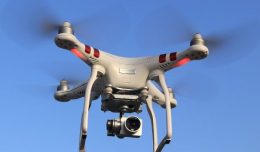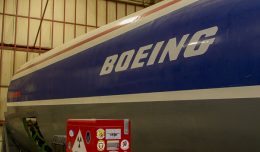In the earliest days of aviation, there were no crosswind landings. Airports (or aerodromes as they were often called at the time) were simply open fields and pilots would takeoff and land into the wind. Over time, airplanes started requiring greater takeoff distances. This meant that there was a need to purchase and maintain a large field in order to accomodate the newer aircraft. Because of this, the transition was made away from open fields to airports with designated runways. Under ideal circumstances, runways are aligned to the prevailing winds in the region. However, it is only occasionally that the wind will be perfectly aligned with the runway. Therefore, most takeoffs and landings will be with the wind blowing at least somewhat across the runway. This is known as a “crosswind”.
Pilots use a special technique to counter these crosswinds on takeoff and landing. The pilot will bank into the wind, and then apply opposite rudder to turn the airplane away from the wind and align it with the runway. In effect, the pilot is making the airplane fly sideways into the wind just as much as the wind is pushing on the airplane. As a result, the airplane remains aligned with the runway. This technique is known as a ‘sideslip’. Proper application of this technique is vital in aircraft with conventional landing gear. These aircraft have the main landing gear towards the front and a wheel under the tail, or a tailwheel, that swivels to allow steering. If the pilot of one of these aircraft did not correctly compensate for the wind, the airplane would turn around or ‘groundloop’. The likely outcome in this event would be damage to the airplane.
Many modern aircraft designs use tricycle landing gear. On these, the steerable wheel or wheels are located at the nose, while the main landing gear are further back on the fuselage. The advantage of this
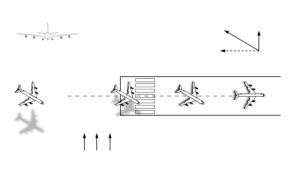
Landing in a crab. The centerline of the aircraft stays at an angle to the runway until the wheels touchdown.
(Source: Wikimedia Commons)
design in a crosswind is that it can be landed in an angle, or “crabbed”. Though they were not designed to do this on a regular or extreme basis, this design will correct the occasional minor piloting error, without the risk of a groundloop.
When the jet airliners appeared in the late 1950’s, the gear was designed to withstand repeated hard landings and side loads. Though pilots could now land in a crab, this was considered sloppy technique and also jostled the passengers on touchdown. In the 1960’s, Pratt and Whitney developed the much larger diameter JT-3D turbofan. The ground clearance on these engines mounted on the wings of the 707 greatly limited the amount of bank or “wing down” that could be used on a crosswind landing. Airlines began training crews to only use limited bank in crosswind landings and let the gear absorb the remainder of the crab from the crosswind landing. Pilots using the full amount of bank for the crosswind risked dragging the number 1 or number 4 engine on the runway. The 737 was also limited in such a manner when the CFM engines were introduced on the 737-300. The 737 was further limited when the wings were lengthened on the Next Generation models (-600, -700, -800, and -900), putting wing tips at risk with an excessive amount of bank on landing.
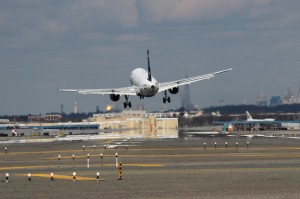
A JetBlue A320 lands in a stiff crosswind at New York’s John F. Kennedy International Airport. Shown here is the hybrid crab/sideslip technique.
(Source: Ben Granucci, NYCAviation)
Today, airliner pilots will use one of three techniques when landing in a crosswind. The traditional method of banking into the wind as much as is required to compensate fully for the winds is the ideal. There are two distinct advantages to this method. The first is that done properly, it will result in zero side loading of the gear, allowing for a smooth landing. The second is that this method actually induces a stabilizing effect to the airplane. Making the airplane fly sideways creates a large amount of drag. When a wind gust strikes an airplane being flown this way, there will be a rise in the amount of drag. The banked wings will also generate more lift. The horizontal component of the lift is what is causing the airplane to fly sideways. The gust will cause an increase of this and again, partially check the negative effect of the wind gust trying to push the aircraft off the runway. This technique requires an alert pilot with excellent flying skills, and is only applicable on certain aircraft. It is most commonly used in light crosswind conditions.
When the crosswind is stronger, the common technique is to land the aircraft partially banked and partially in a crab. This hybrid method enjoys some of the advantages of the traditional technique, but does not greatly risk dragging a wingtip or engine pod in strong winds. It is also far easier to conduct in all crosswind conditions than the traditional technique. Airplane manufacturer Airbus recommends that pilots of its aircraft use this technique.
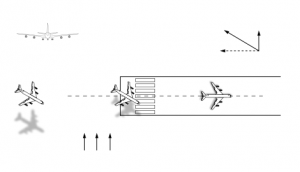
A proper landing in a crab requires the pilots to perform a de-crab maneuver, also referred to as “kicking it out” (Source: Wikimedia Commons)
The third technique is for the pilot to maintain the wings level, and then just a couple of seconds prior to touchdown push the rudder to align the fuselage with the runway. To properly conduct this technique, the pilot must be acutely aware of the airplane’s position and have good flying skills. This technique greatly reduces the side loading forces on the gear and does not push the passengers to the sides of their seats like the traditional technique, though it is not as stable. Pilots refer to this as “kicking it out”.
There is one other technique, but it is not really a technique at all, and that is when the pilot allows the aircraft to land in the crab with the gear absorbing the entire load of the crosswind. This technique is the most simple to conduct and provides a more comfortable ride for the passengers until touchtown. On landing, the passengers will be abruptly pushed to the sides of their seats. On airplanes with two- and three- axle bogies, the aircraft will tend to shutter on touchdown.
Pilots will also generally fly the approach a little faster during crosswind and gusting conditions. At airports with exceptionally long runways, this is permissible and the extra speed results in a slightly more responsive airplane. The pilots will often maintain this extra speed through landing, touching down in a more flat attitude than normal. If the runway length is limited, this may not be an option.
As crosswinds approach the maximum allowed for a particular aircraft, the landings can become quite dramatic. One airport that can be prone to extreme crosswinds is Birmingham Airport (BHX) in the United Kingdom. Recently, a video of a First Choice Airways 767-300ER landing at BHX has gone viral on YouTube, with nearly 7 million views so far and counting.
Without data from the flight data recorder, it is difficult to definitively evaluate this landing. The strength of the crosswind and the gusting conditions of the day would challenge any level of pilot. From the attitude of the airplane, it appears the pilot was maintaining some extra airspeed resulting in less of a nose up approach. The touchdown put an exceptional vertical and side load on the main landing gear. Though the gear is designed to take these loads and more, it is still taxing on the airplane. It is unclear if the pilot was planning on landing in a crab, transitioning to a partial crab/crosswind technique, or on “kicking it out” in the last few seconds before being interrupted by the touchdown. The end result was unsatisfactory for the passengers and probably in the pilots’ own opinions as well.
The video below was shot at Chicago O’Hare International airport earlier this year. On a day with an apparent steady crosswind from the left, quite a few landings are shown using various techniques. A KLM 747 starts it off with a beautiful traditional technique. Later in the video, there is an excellent example of a Lufthansa 340 landing partially crabbed and partially wing down. Near the end, there is a Swiss 330 that clearly demonstrates the “kick it out” technique. You will see other variants of these as well as a couple of airplanes that land in a crab without correction.
Depending on the conditions, the type of airplane, and the pilot, you are likely to encounter any of the above techniques when you travel by air. The technique and the quality will vary, but one thing is for certain, the majority of the takeoffs and landings will be in crosswind conditions.
NYCAviation Columnist David J. Williams is a former airline captain who is currently involved with aviation safety.





